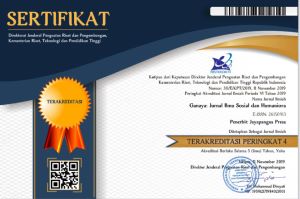Artifactual Communication Activities of the transfer of the 10th Century Mahendradatta Women’s Historical Women’s History
DOI:
https://doi.org/10.37329/ganaya.v6i4.2507Keywords:
Artifactual Communication, Transfer of Vehicles, MahendrattaAbstract
One of the most important needs besides food and shelter is clothing, a primary human need. The purpose of this study is to determine the audience's acceptance of the transfer of the history of women in the 10th century AD in the figure of Mahendradatta in the hertorianke style in artifactual communication activities and its communication applications in transferring the history of women in the 10th century AD with the figure of Mahendradatta to fashion brands carried out. This research belongs to the type of qualitative research. In this study, the technique used to select informants. The result of the research is the meaning of the Herstori fashion brand in artifactual communication activities as a vehicle for women's history in the 10th century AD. With the presence of Herstori, Mahendradatta is adequate. The change of vehicle that occurred in the fashion-themed "Mahendradatta Chapter 1" by Herstori experienced many significant changes. These changes can be seen in the character substructure, which has shrunk, and the plot, which has undergone various changes. Apart from that, the creative process of transferring vehicles from the historical tradition of 10th-century women with the figure of Mahendradatta to fashion turned out to be a crucial and great idea as a form of cultural preservation and environmental awareness. In transferring the visualization of the vehicle, the character's image can be further displayed in the fashion presented by Herstori. In addition, other themes of the fashion series can be lifted from folklore from various regions in Indonesia.
References
Arifin, M. N. (2019). Pengaruh Status Sosial Ekonomi Orang Tua Terhadap Gaya Hidup Mahasiswa (Studi Kasus Kualitatif Status Sosial Ekonomi Orang Tua terhadap Gaya Hidup Sandang dan Pangan Mahasiswa Fakultas Hukum Universitas Sebelas Maret Surakarta).
Bungin, B. (2013). Metodologi Penelitian Sosial & ekonomi: Format-format kuantitatif dan Kualitatif untuk studi sosiologi, kebijakan publik, komunikasi, manajemen, dan pemasaran.
Cut, A. (2021). Fashion Sebagai Media Komunikasi Arti Faktual Dalam Pembentukkan Identitas Sosial Islam (Studi Pada Mahasiswa Komunikasi Dan Penyiaran Islam Fakultas Dakwah Dan Ilmu Komunikasi Universitas Islam Negeri Raden Intan Lampung). Universitas Islam Negeri Raden Intan Lampung.
Haryanti, I., & Nurdin, H. (2021). Trend Fashion Dan Gaya Hidup Hedonis Terhadap Keputusan Pembelian Pakaian Berhijab Di Kota Bima. Jurnal Sains Manajemen Dan Bisnis Indonesia, 11(2), 124–135.
Istiyanto, S. B. (2010). Pentingnya komunikasi artifaktual dalam keberhasilan modifikasi komunikasi antarmanusia. Acta Diurna, 6(2), 12–22.
Karina, N. I. (2018). Perilaku Komunikasi Pegawai Fashion Brand Mango Dalam Memberikan Pelayanan Kepada Konsumen (Studi Deskriptif Mengenai Perilaku Komunikasi Pegawai Fashion Brand Mango dalam Memberikan Pelayanan Kepada Konsumen di Mall PVJ Bandung). Universitas Komputer Indonesia.
Khoiri, M. A. (2016). Fiqih Busana Telaah Kritis Pemikiran Muhammad Syahrur. Yogyakarta: Kalimedia.
Lestari, S. B. (2014). Fashion sebagai Komunikasi Identitas Sosial di Kalangan Mahasiswa.
Madjid, M. D., & Wahyudhi, J. (2014). Ilmu Sejarah: Sebuah Pengantar. Kencana.
Maulina, L. (2020). Pengaruh Celebrity Endorser, Fashion Brand Image, Dan Attitude Terhadap Repurchase Intention Trend Busana Muslim Pada Generasi Milenial Muslim. UNIVERSITAS AIRLANGGA.
Menoreh, B. B., & Setiawan, S. (2021). Pengaruh Unsur Military Terhadap Desain Fashion Kalangan Muda di Indonesia. Jurnal Desain Indonesia., 3(1), 1–10.
Nurjana, I., Anrial, A., & Kamil, P. (2020). Budaya dan Agama: Pola Komunikasi Tradisi Belah Kelapa di atas Kuburan (Desa Weskust, Kecamatan Kepahiang, Kabupaten Kepahiang). IAIN Curup.
Nurmala, M. D., Wibowo, T. U. S. H., & Rachmayani, A. (2020). Tingkat Stres Mahasiswa Dalam Pembelajaran Online Pada Masa Pandemi Covid-19. Jurnal Penelitian Bimbingan Dan Konseling, 5(2).
Poerwanto, P., & Yudha, R. P. (2019). Persepsi Generasi Millineal terhadap Jilbab sebagai Identitas, Fesyen, Komunikasi Nonverbal dan Kreativitas. Journal of Tourism and Creativity, 3(1).
Pratiwi, C. A. (2021). Persepsi Dosen Terhadap Trend Fashion (Studi Pada Fakultas Ushuluddin dan Dakwah IAIN Kediri). IAIN Kediri.
Selviana, L. (2021). Trend Fashion Muslimah Sebagai Pesan Keagamaan (Studi Kasus Mahasiswa Program Studi Komunikasi dan Penyiaran Islam IAIN Jember). Fakultas Dakwah Program Studi Komunikasi dan Penyiaran Islam.
Setiawan, D., Haryono, T., & Burhan, A. (2014). The Public Space of “Jogja Fashion Week Carnival” and Cosplay Clothing in Yogyakarta. KOMUNITAS: International Journal of Indonesian Society and Culture, 6(2), 237–245.
Siregar, P. D. (2017). Strategi Komunikasi Pemasaran Terpadu Semarang Fashion Parade Membangun Ekuitas Merek Produk Fashion Lokal Berkualitas. Program Studi Komunikasi FISKOM-UKSW.
Soerjono Sukanto. (2014). Kamus Sosiologi. Jakarta: Raja Graffindo.
Utari, R. I. (2015). Pakaian Sebagai Komunikasi Artifaktual: Studi Interaksi Simbolik Tentang Pencitraan Dalam Penampilan Melalui Pakaian Mahasiswa Manajemen Di Universitas Kristen Maranatha.
Downloads
Published
How to Cite
Issue
Section
License
Copyright (c) 2023 Nina Septiana Ratnawulan, Gyan Prahasti, Merli Pelagia (Author)

This work is licensed under a Creative Commons Attribution-ShareAlike 4.0 International License.
An author who publishes in the Ganaya : Jurnal Ilmu Sosial dan Humaniora agrees to the following terms:
- Author retains the copyright and grants the journal the right of first publication of the work simultaneously licensed under the Creative Commons Attribution-ShareAlike 4.0 License that allows others to share the work with an acknowledgement of the work's authorship and initial publication in this journal
- Author is able to enter into separate, additional contractual arrangements for the non-exclusive distribution of the journal's published version of the work (e.g., post it to an institutional repository or publish it in a book) with the acknowledgement of its initial publication in this journal.
- Author is permitted and encouraged to post his/her work online (e.g., in institutional repositories or on their website) prior to and during the submission process, as it can lead to productive exchanges, as well as earlier and greater citation of the published work (See The Effect of Open Access).
Read more about the Creative Commons Attribution-ShareAlike 4.0 Licence here: https://creativecommons.org/licenses/by-sa/4.0/.








